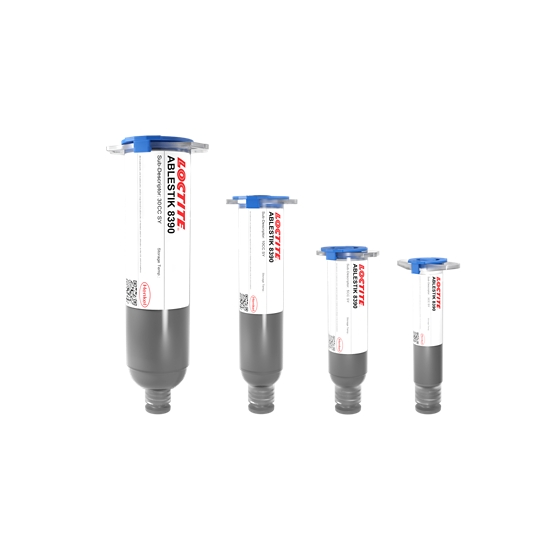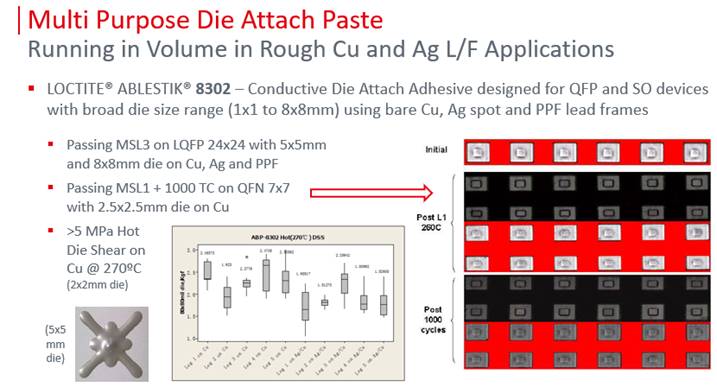LOCTITE ABLESTIK 8302
Harmonization Code : 3506.91.90.99 | Prepared glues and other prepared adhesives, not elsewhere specified or included; products suitable for use as glues or adhesives, put up for retail sale as glues or adhesives, not exceeding a net weight of 1 kg ; Adhesives based on polymers of headings 3901 to 3913 or on rubber; Other ; Other
Main features
- Excellent peel strength
- Low moisture absorption
- Improved JEDEC performance
Product Description
LOCTITE® ABLESTIK 8302 electrically conductive die attach adhesive is designed for high reliability package applications. It is a heat cured, silver filled die attach paste suited for PPF, Bare copper and Ag plated Cu leadframes.
LOCTITE® ABLESTIK 8302 contains no spacers (and there are no plans to create a spacer version) and is a multi purpose die attach paste, suitable for broad application spaces with relatively low modulus (2000 MPa @ RT, 180 MPa @ 250C). It is designed for QFP and SO devices with broad die size range (1x1 to 8x8mm) using Bare Cu, Ag spot and PPF leadframes.
Cure Schedule
- 30 minute ramp from 25°C to 175°C + 60 minutes @ 175°C
- 45 minute ramp from 25°C to 200°C + 60 minutes @ 200°C
Technical Specifications
| General Properties | |||||||||||||
| Density Density Volumetric mass per unit | 3.8 kg/m3 | ||||||||||||
| Work life @25°C Work life @25°C Work life is the amount of time we have to work with a material until it is no longer able to be easily worked and applied on a substrate. It is based on the change in viscosity and it can rely on the application requirements. | 24 hours | ||||||||||||
| |||||||||||||
| Physical Properties | |||||||||||||
| Thixotropic index Thixotropic index Thixotropic Index is a ratio of a material s viscosity at two different speeds in Ambient temperature, generally different by a factor of ten. A thixotropic material s viscosity will decrease as agitation or pressure is increased. It indicates the capability of a material to hold its shape. Mayonnaise is a great example of this. It holds its shape very well, but when a shear stress is applied, the material easily spreads. It helps in choosing a material in accordance to the application, dispense method and viscosity of a material. | 5 | ||||||||||||
| Viscosity Viscosity Viscosity is a measurement of a fluid’s resistance to flow. Viscosity is commonly measured in centiPoise (cP). One cP is defined as the viscosity of water and all other viscosities are derived from this base. MPa is another common unit with a 1:1 conversion to cP. A product like honey would have a much higher viscosity -around 10,000 cPs- compared to water. As a result, honey would flow much slower out of a tipped glass than water would. The viscosity of a material can be decreased with an increase in temperature in order to better suit an application | 10,500 mPa.s | ||||||||||||
| Chemical Properties | |||||||||||||
| |||||||||||||
| Mechanical Properties | |||||||||||||
| |||||||||||||
| |||||||||||||
| Electrical Properties | |||||||||||||
| Volume Resistivity Volume Resistivity Volume resistivity, also called volume resistance, bulk resistance or bulk resistivity is a thickness dependent measurement of the resistivity of a material perpendicular to the plane of the surface. | 1.0x10-4 Ohms⋅cm | ||||||||||||
| Thermal Properties | |||||||||||||
| |||||||||||||
| Glass Transition Temperature (Tg) Glass Transition Temperature (Tg) The glass transition temperature for organic adhesives is a temperature region where the polymers change from glassy and brittle to soft and rubbery. Increasing the temperature further continues the softening process as the viscosity drops too. Temperatures between the glass transition temperature and below the decomposition point of the adhesive are the best region for bonding. The glass-transition temperature Tg of a material characterizes the range of temperatures over which this glass transition occurs. | 30 °C | ||||||||||||
| Thermal Conductivity Thermal Conductivity Thermal conductivity describes the ability of a material to conduct heat. It is required by power packages in order to dissipate heat and maintain stable electrical performance. Thermal conductivity units are [W/(m K)] in the SI system and [Btu/(hr ft °F)] in the Imperial system. | 0.8 W/m.K | ||||||||||||




